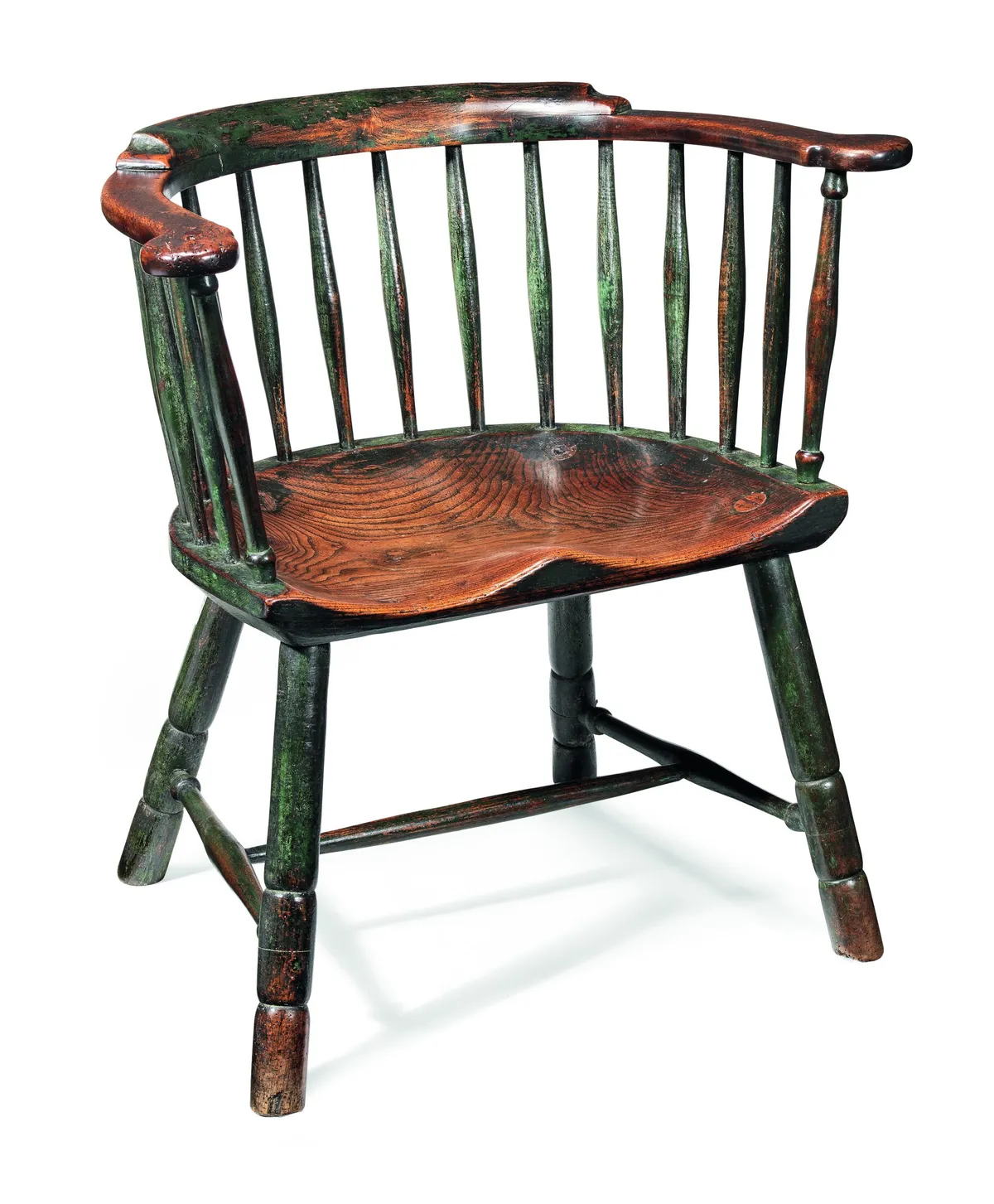As the nights draw in, little speaks of classic hearthside comfort better than an antique Windsor chair. No farmhouse kitchen would be complete without one – and an obligatory snoozing cat.
It’s an English design classic. Turned beech wood legs are pushed into sturdy elm seats, carved to fit the shape of the human body. Beech is a soft wood that can be easily turned on a lathe, while elm is a hard wood, with figuring similar to oak, which doesn’t split if you drill holes near the edge of the seat. The arms and back of the chair (the uprights) are made from either ash or yew. Both of these woods can be bent, curved and manipulated under steam pressure.
Why Windsor? As with so many other antiques there’s a romantic – if fantastical – tale. The story goes that King George III was out hunting in Windsor Great Park and sheltered from a storm in a humble cottage. He was so taken with the simple, comfortable chair he was offered to sit on that he ordered the court cabinetmaker to copy the design for Windsor Castle.
The more accurate account is that the Windsor chair was made across the country. It’s thought that the ancient town of Windsor, with its proximity to London and situation on the River Thames became an important centre for their sale – in similar fashion to the old market town of Stilton giving its name to the famous cheese.
Certainly Buckinghamshire was a significant county in the manufacture of Windsor chairs. During the warm summer months, ‘bodgers’ camped in the woods of the Chiltern Hills and turned legs and spindles directly from the green wood of the noble beech tree. The finished article could then be taken down to High Wycombe and sold to the numerous furniture makers. Samuel Rockall, one of the last Chiltern chair bodgers, died in 1962.
The earliest mention of a ‘Windsor’ dates to the 1720s, and it is thought that they were originally used as outdoors or garden chairs. Painted green, they were also known as ‘Forest Chairs’. Windsor chairs with their original green paint can still be seen under the portico at West Wycombe Park, the former seat of Sir Francis Dashwood, founder of the notorious 1700s Hellfire club, quite possibly still to be found in the same place they were left over 250 years ago.
At auction, decent mid 19th-century Windsors can be bought relatively cheaply for a few hundred pounds. The later 1920s ‘wheel-back’ versions (those with a cart wheel design as beloved of tea rooms and country pubs) can be had for virtually nothing. If you hanker after an 18th-century example, things start to get much more expensive. I was lucky enough to inherit mine from my grandfather (and it may have been his father's before him). Like the rarer ‘comb-backs’, which were the earliest to be made and which often have cabriole legs in the French style, I suspect if it were sold an estimate might be put at £3,000-£5,000. That said, a similar comb-back Windsor sold at Martel Maides Auctions in 2012 for £6,200.
How to buy and collect Windsor chairs
Today these antique pieces of rustic country furniture that have been smoothed and shaped through use over the centuries are being snapped up by antiques lovers and interior designers such as Max Rollitt, as they work so well in so many interior schemes. Here are some tips for picking your own beauty...

1
Spot the key features
A key feature of a Windsor chair is a seat made of one solid slab of wood, usually elm, but sometimes other woods such as sycamore or oak.
The legs, made of ash, beech and sometimes yew, are attached with a mortise and tenon joint, while the spindles forming the back rest are hand turned and shaped, and slotted in from above.
2
Windsors don't always have arms
There are side chairs as well as armchairs – some have stick backs while others have curvy spindles. Others have ornately carved back splats – gothic-back Windsor chairs, for example – but they all have a look that ties them together.
3
Be aware of regional differences
‘They vary slightly from region to region,’ says Sam Cunningham of Cunningham White's. ‘The way the legs, arms and spindles are attached can be different. Some are a steam-bent hoop for the arms and the back, while in others the arms are made from three different parts.
The three-part armchair is common in the West Country. The shape of the seat also varies – a Cornish Windsor chair has a flat-fronted seat, while a Thames Valley version has a more rounded seat. The carving in the central splat varies from region to region and maker to maker.’
4
Embrace the wear and imperfections
When buying an antique Windsor chair, Sam says we should beware of reproductions and make sure the seat is sturdy. ‘There should be imperfections and a lot of wear. You should be able to see the hand of the person who made it. Windsor chairs were built to be used, so theoldest examples have a lot of wear. You can tell by the feel ofit. The edges are smooth. The left arm may be more worn where the person would get up and down. These chairs should connect you with the previous people whosat in them. They have a history to tell. For the vast majority of Windsor chairs, we don’t know who originally made them or who owned them. That’s down
to your imagination.’
